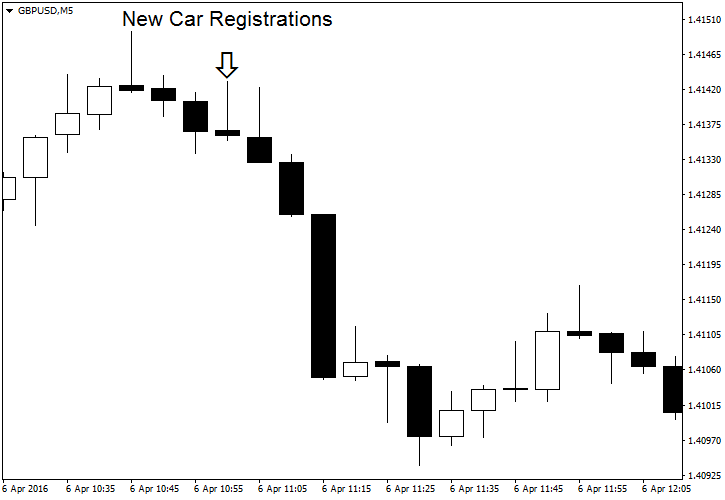
Unarguably, the most popular technical indicator in Forex trading is moving average. The fundamental factors influencing the currencies are far more varied than the perceived technical forces (momentum, support and resistance, pivots). Moreover, traders assign different degrees of importance to different factors. Some prefer employment indicators, others watch changes in commodity price indices. Below, I attempt to summarize the wide range of fundamental indicators, providing brief explanation and examples for each of them. Near the end of the post, you can vote for the top three indicators you use in fundamental analysis.
Contents
- 1 Automotive Industry
- 2 Commodity Indicators
- 3 CPI (Inflation)
- 4 Current Account
- 5 Employment
- 6 GDP (Gross Domestic Product)
- 7 Interest Rates
- 8 Real Estate Market
- 9 Sentiment Indices
- 10 Stock Market Performance
- vote
Automotive Industry
Automotive industry plays a huge role in economy. First, it provides employment to thousands of people. Second, it creates demand for commodities and products of other industries. Finally, the demand for automobiles indicates the willingness of population to spend money on durable goods. In this sense, any car sales index helps traders to assess the state of the economy using an indirect but timely reported measure. It takes one month to get the preliminary GDP report for the previous quarter whereas vehicle sales data for the previous month is normally available in the beginning of the next month. The big problem with such industry reports is that there is a number of reasons for the sales number to fluctuate, and not all of them are of economic nature — for example, cars coming into or out of fashion. Moreover, car industry’s role decreases each year as the developed nation advances further from the manufacturing based economy.
You can see the

The following monthly reports demonstrate examples of the auto industry fundamental indicators followed by FX traders:
United States
Eurozone
United Kingdom
Japan
Australia
New Zealand
Switzerland
Canada
Commodity Indicators
Commodity indicators come in different flavors: futures prices, compiled price indices, inventories reports, production estimates, supply and demand forecasts, etc. With some notable exceptions, the modern developed nations’ economies hardly depend on commodity prices except for the crude oil. However, exports of particular commodities play a significant part in some countries’ exports: New Zealand relies on its dairy farming, South Africa exports gold, platinum, and iron ore, and Canada is known for its oil industry.
Normally, higher exports commodity output and prices are good for the country’s currency because it tends to promote economic growth. At the same time, lower energy commodities prices are good to all importing countries as they make production and living cheaper, freeing disposable income. Disruption in commodity production in one part of the world could be a boon to a country exporting the same commodity in the other part of the world due to a perceived price surge.
Gold price dynamics is important to most of the currency traders due to its indication of the market’s general risk aversion or risk hunger — gold tends to rise during the times of low tolerance for risk and fall during the periods when investors are willing to hold risky assets. However, in recent times, gold can exhibit a different behavior pattern — falling and rising depending on availability of safe options with high yields (currencies with high interest rates or bullish stock markets).
See the USD/CHF pair’s correlation with spot Gold rate. Gold uses inverted scale (left) and is shown in green/orange candles. USD/CHF uses normal scale (right) and is shown in black:
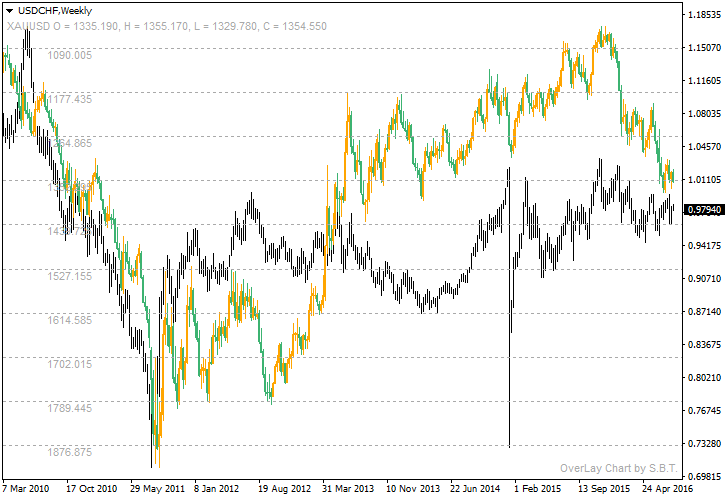
Notable correlation can be seen on this NZD/USD monthly chart with overlay of GDT Price Index (dairy prices). NZD/USD is in black, GDT is in red:
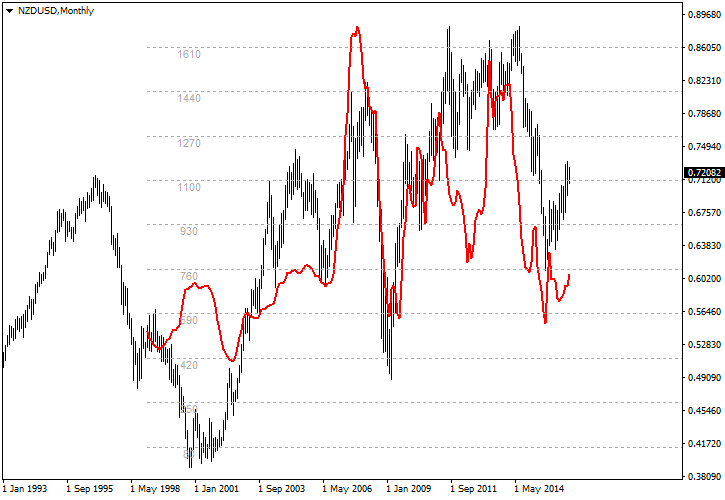
Here is the list of indicators based on commodity markets and followed by FX traders:
United States
Australia
New Zealand
Other
CPI (Inflation)
CPI (or inflation in general) is an important fundamental indicator because it directly affects every central bank’s monetary policy. Central banks are mandated to promote moderate price growth (at about 2% per year), so higher inflation normally means higher interest rates, which will attract buyers and send the currency growing. In reality, it works that way only with developed nations with low or moderate inflation. Countries with historically elevated inflation rates do not get their currency appreciating via higher price index values.
Price indices come in two general varieties: consumer and producer. While central banks are interested mostly in consumer price inflation, producer price inflation is a helpful tool in assessing potential increases or decreases in the former.
On the chart below, you can see how
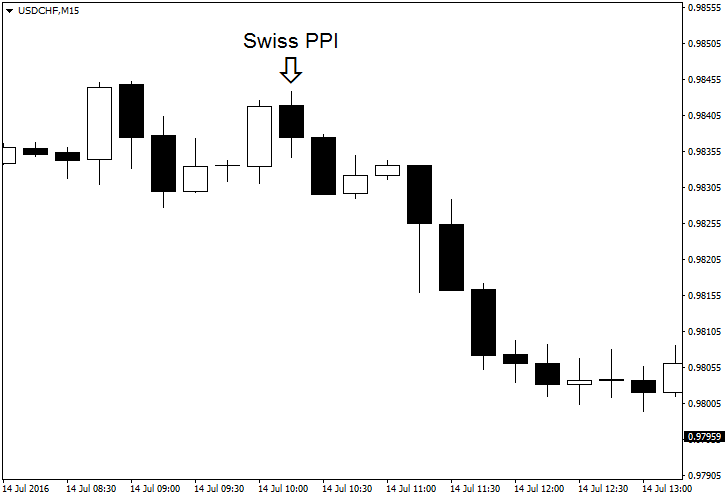
Here is the list of inflation reports for the major currencies (monthly unless stated otherwise).
United States
Eurozone
United Kingdom
Japan
Australia
New Zealand
Switzerland
Canada
Current Account
Current account is actually an umbrella term for two major indicators: trade balance and net foreign purchases of the country’s
You can see a demonstration of current account’s effect on the Forex market on this chart. It shows how a poor International transactions in securities report from Canada affected USD/CAD in July 2016:
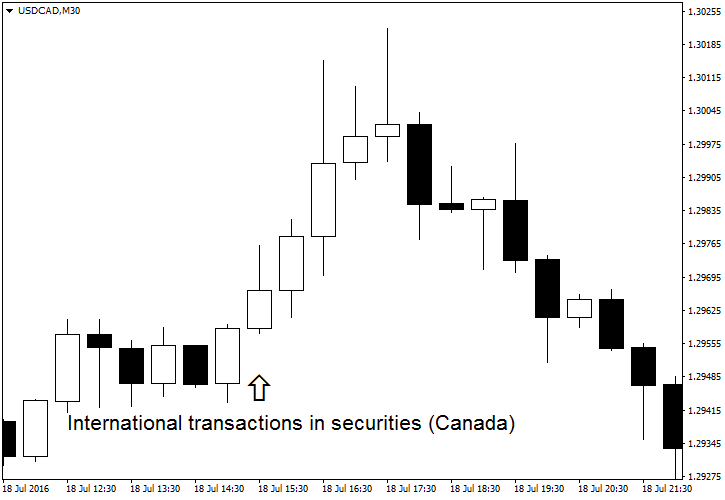
Current account indicators for the major currencies include the following list.
United States
Eurozone
United Kingdom
Japan
Australia
New Zealand
Switzerland
Canada
Employment
Employment is an important economic factor. Rising employment implies rising consumer spending power and indicates that businesses are expanding via job creation. Upholding maximum employment is a crucial part of the Federal Reserve’s mandate. Others (like the Reserve Bank of Australia or the Bank of England) mention promoting the employment as one of the objectives of their monetary policy. Thus, improving employment benefits the currency in two ways — by indicating stronger economic growth and by allowing the central bank to keep interest rates at a higher level.
This positive Nonfarm Payroll Employment report released in the USA on August 5, 2016, shows how powerful jobs data can be in Forex:
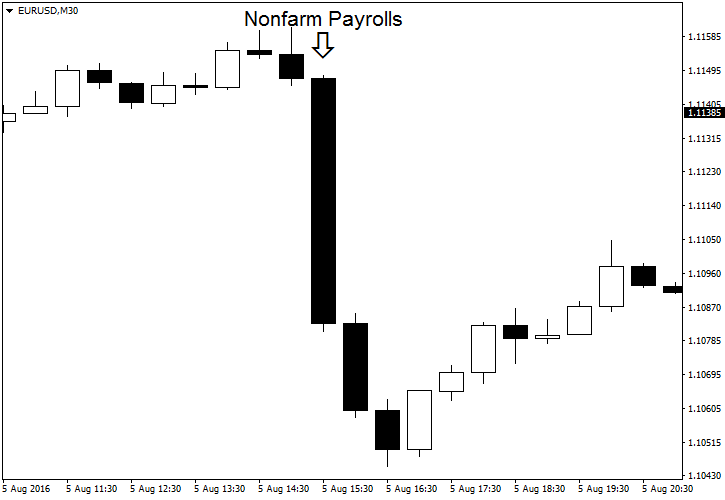
Notable employment reports watched by Forex market participants are listed below.
United States
Eurozone
United Kingdom
Japan
Australia
New Zealand
Switzerland
Canada
GDP (Gross Domestic Product)
GDP (Gross domestic product) is the single universally accepted measure of the economic output. It is a broad measure that tries to encompass as much data as practically possible and it has its disadvantages. However, it is one of the strongest factors that affect the Forex rates — and not only upon the GDP value announcements, but also as the estimates and forecasts of the indicator change. Actual GDP is reported quarterly but, for example, in the USA, we get 3 reports per quarter — advance, preliminary, and final estimates for the quarter. Also, some other fundamental monthly reports serve as an intermediate for GDP growth assessment: industrial production, retail sales, business inventories, manufacturing sales, durable goods orders, etc.
You can see how dismal GDP report from the United States sends EUR/USD up in late July this year:
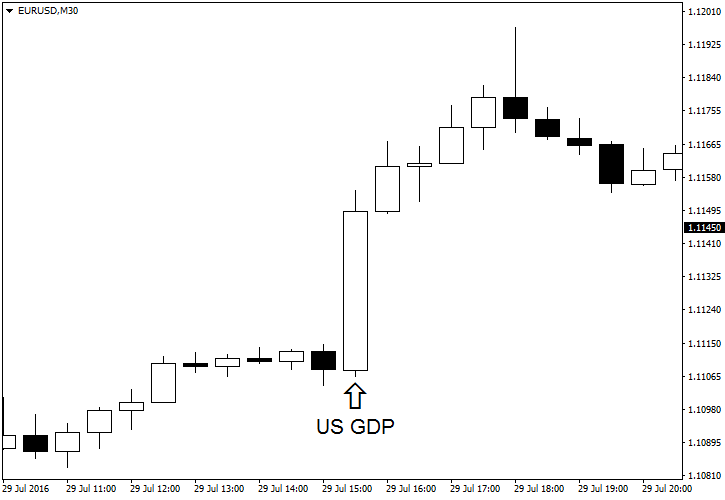
Below is the list of economic growth related reports for the major currencies.
United States
Eurozone
United Kingdom
Japan
Australia
New Zealand
Switzerland
Canada
Interest Rates
Interest rates are the unique fundamental indicator in that they also add real value to the traded currencies. While holding gold or some other tangible investment normally incurs storage costs, holding cash in a high interest rate currency results in passive gain. Central banks control the reference interest rate, which affects all other interest rates associated with currency. Although brokers apply rollover interest spreads to the swap rates paid and charged on your retail trading positions, your overnight interest rate is also based on the one set by the central banks.
FOMC’s July 2016 decision to keep interest rates unchanged in the USA was not anything unexpected, but the hints of less rate increases in the near future sent the EUR/USD rate rallying:
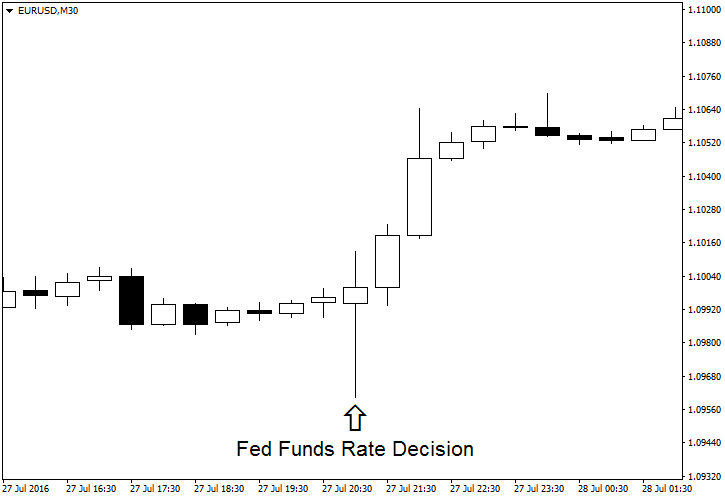
Below you will find the list of the major central banks’ pages providing information on their main interest rates.
United States
Eurozone
United Kingdom
Japan
Australia
New Zealand
Switzerland
Canada
Real Estate Market
Real estate market provides a number of indicators for the currency traders to assess the state of the country’s economy and desirability of its currency to foreign investors. Healthy and growing housing market demonstrates normal economic development and provides incentives to domestic investors, which results in construction job creation and increased demand for infrastructure commodities. At the same time, rising house prices attract foreign investors, providing additional demand for the domestic currency. It should be noted, that a hot real estate market may quickly turn from boon to bane if the asset bubble forms and bursts uncontrollably.
On the example chart below, you can see how a positive House Price Index report from British Halifax helped the pound vs. the US dollar on June 7 this year:
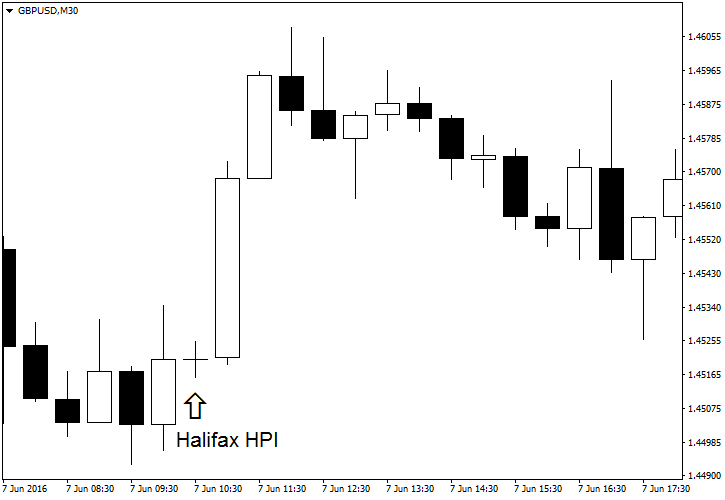
The list of housing market indicators affecting the major currencies is provided below:
United States
Eurozone
United Kingdom
Japan
Australia
New Zealand
Switzerland
Canada
Sentiment Indices
Sentiment indices is probably the widest group of fundamental indicators. They can be divided into three categories: manufacturing, services, and consumer. Neither of three offer objective picture of the economic situation, but rather try to present an intersubjective view. The advantage of the sentiment survey indicators is that they help traders to assess the strength or weakness of the particular sector of the economy in advance. Such indicators are usually reported twice per month — first, preliminary values and then, the final ones. This results in a leading fundamental indicator. Higher confidence readings suggest expansion, while lower readings suggest contraction. Currencies tend to rise on optimistic reports and fall on those below expectations. Smart traders also learn to use sentiment indicators to forecast other macroeconomic statistics.
You can see how sentiment indicators affect the currency market with this Consumer Confidence example. A
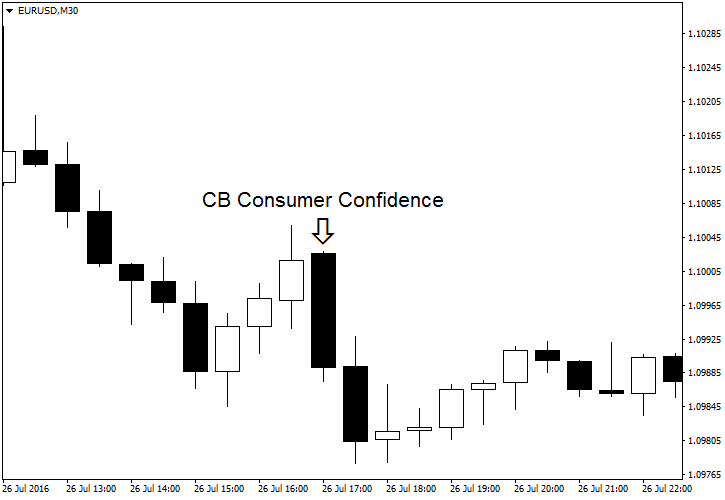
The sentiment index industry is dominated by Markit, but there are other noteworthy reports in this field too. Below is the list of the most important sentiment indicators for the major currencies:
United States
Eurozone
United Kingdom
Japan
Australia
New Zealand
Switzerland
Canada
Stock Market Performance
Stock market performance is somewhat similar in its effect to the commodity prices mentioned earlier. Stock prices rally when traders and investors are full of optimism towards the country’s economy. Under normal conditions, stock indices’ growth results in the domestic currency rallies. However, there are feedback loops that make things quite complicated. First, the equities tend to rise as the country’s interest rate falls (including when expectations of the future interest rate value are lowered), which is a bearish factor for the currencies. Second, rising stock prices may be a signal of a higher tolerance for risk, which can poorly affect the
The correlation chart of EUR/USD and the Dow Jones Industrial Average index is shown below. DJI uses inverted scale (left) and is shown in green/orange candles. EUR/USD uses normal scale (right) and is shown in black and white:
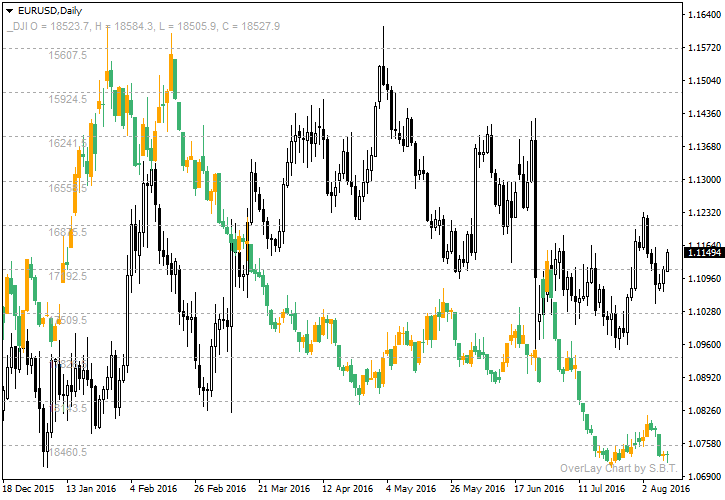
The list of the main stock market indices relevant to major currencies are listed below.
United States
Eurozone
United Kingdom
Japan
Australia
New Zealand
Switzerland
Canada
Poll
I believe that in the foreign exchange market, the indisputable king of fundamental factors is the central banks’ interest rates. They are followed by GDP and CPI. And how about you?
![]() Loading …
Loading …
If you want to share your thoughts on using the fundamental indicators in Forex trading, please feel free to reply using the commentary form below.